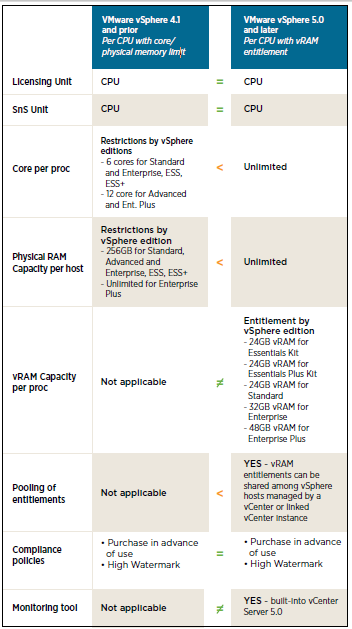As you no doubt heard by now, VMware has announced a new version of vSphere along with some new or improved features however, this post will not highlight these features. In this post, I want to talk about what did not improve – the licensing.
With the announcement of the VMware vSphere 5, the biggest thing that startles me is the way that VMware has found to a way to collect more revenue from users with new server technologies. This seems to be totally going against the flow of x86 market since the main message of the major server manufacturers (in the past) has been how they can save users $$ on VMware licensing by offering the ability to stack your servers full of memory.
For example – take a look at the IBM HX5 blade server combined with the MAX 5 which provides users with a total of 40 memory DIMM slots and a current maximum of 640GB using only two processors. Taking a look at the comparison, with the previous vSphere 4.x licensing, you would only need two VMware vSphere 4.x Enterprise Plus licenses. (With 640GB of RAM, one can only imagine how many virtual machines were possible with just 2 licenses.)
Since more users were moving to at the architecture of larger 2 socket systems with A LOT of memory, I believe that VMware realized the vSphere licensing opportunities were than they expected so they decided to change their licensing method to a “per CPU and memory” licensing model creating the concept of a processor and vRAM pooling of entitlements.
Here is a look at a comparison of vSphere 4.x licensing vs the vSphere 5 model:

So, if we use the example of a the IBM HX5 blade with MAX5 mentioned above maxed out with 640GB of memory with the NEW licensing model a user would need 14 VMware vSphere 5 Enterprise Plus Licenses to be “legal” vs 2 with the current VMware vSphere 4.x licensing model.
According to VMware, the good news is that there is “no limit to the number of cores per processor”, but in reality – I don’t see that that as a big deal. vSphere 4.X already supported 12 cores per processor with vSphere Enterprise Plus licenses which is the maximum of the current market – even the next generation Intel 2 socket CPU will only be 8 cores – so there is no advantage to changing the licensing. This is why many people are calling this new licensing model “vRAM Tax“.
We all agree that VMware has the best products and is the market leader for virtualization, BUT this new licensing model is giving ammo to Microsoft and Citrix to strike at the cost issue (which was already an issue in VS 4.x).
About the Author
Thales Osterne is a contributor for BladesMadeSimple.com. He has over six years in the IT field with four years of experience in IBM BladeCenter and System X. When he is not blogging, Thales works as a product manager for IBM System X & Bladecenter at Lanlink Informatica, a major business partner in Brazil. He is fluent in Portugese and English.
loratadine side effects
hairstyles for women
great smoky mountains
facial hair styles
farm and home
Pingback: Kevin Houston
Pingback: Kevin Houston
Pingback: Artek
Pingback: Thomas Jones
Pingback: Jay Livens
Pingback: Julian Frank
Good post, Thales. I hope we see more from you in the future.
The removal of the core limit might not be as important for the 8-core Intel CPUs, but it was for the soon-to-launch 16-core Opterons from AMD.
If the vRAM Tax sticks, it does help ease some of the pain that blade users feel for getting fewer DIMM slots than larger servers. (e.g. 64 DIMMs on a standard x3850 versus 32 on a 4-socket HX5 configuration).
Great post, Thales! As we can see from your article, Microsoft can increase sales with this licensing strategy adopted by VMWare. Let’s wait and see! =)
Pingback: Elijah Paul
Pingback: VMware vSphere 5 licensing aka #vTax : the opinions and math | UP2V
I too was upset my this change. The only unknown variable at this point seems to be what the cost of each license will be. If they are significantly less expensive than the vsphere 4 licenses, it may be a wash.
It seems all of the hardware vendors (esp Cisco) built their strategies around the previous licensing model, and now vmware pulls the rug out.
Regarding 16-core AMD CPUs it’s starting to become a defintion of what a CPU core really is. AMD is introducing the concept “module” which could be defined either as two CPU cores (though not fully independent of one another) or seen as a single CPU core with CMT (Cluster Multi-Threading) which is a more far-reaching method of multi-threading than SMT (Simultaneous Multi-Threading) that Intels uses (known by most as simply HyperThreading).
It seems as though AMD choose to define this according to the former definition to get bragging rights of the highest number of CPU cores. Intels cores has been faster than AMDs cores for quite sometime and this could make that gap even bigger now that AMD has decided to call the two, not fully independent, processing engines in the Bulldozer modules as cores.
Do you think this licensing change is a tactic for VMware to make money in the case of hosting everything in memory? Memory has become so cheap nowadays and I have been hearing of some software companies eliminating SAN and designing their entire cloud hosted solution to run in memory. Do you believe that VMware is just trying to stay ahead of the curve?
Pingback: Kevin Houston